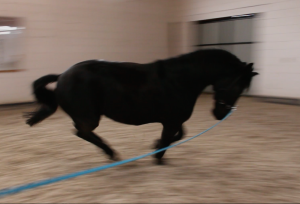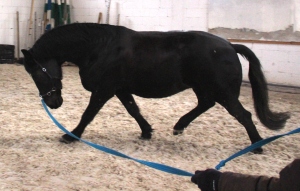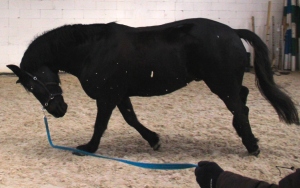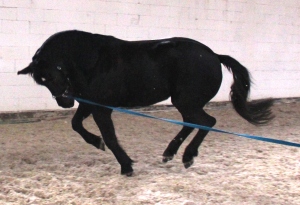Bee and the Horse
The Academic Art of Riding Blog from Poland
Improving Canter

Having canter problems? Read how I’m helping Frisian-mix Weto improve his canter on the lunge.
I love my horse’s canter. It’s like sitting on a rocking chair. The transition from trot is smooth and he is easy to control at all times. TataTAM, TataTAM. Of course, it hasn’t always been like that, but a little practice here and there was all that was necessary, so I didn’t have to give his canter a lot of thought. Seems like he simply has good natural balance.
Weto, on the other hand, surprised me quite a bit when I tried to canter him. He threw some nice bucks and tried to run off in a super fast trot. Next time he almost threw me off. When I attempted to solve the matter on the ground he dragged me around the arena on the lunge. Not good. (I’ve written about that experience here)
Being a really nice guy, Weto is otherwise very safe to ride and always tries his best. Thus, I assumed that starting a canter posed a serious physical problem for him and the bucks were his way of voicing these problems. I ignored advises of “just tell him who’s the boss” and had a closer look at what was going on.
On the lunge I could observe that Weto rolled in his neck every time I asked for a canter, as if held in place by invisible, short draw reigns. You can see the problem on the following pictures:




He also fell on the inner shoulder and got very heavy on the forehand. With so much weight in the front and the head rolled in, it’s almost impossible for him to start cantering (he has to bring his weight more on the haunches and lift himself up in the shoulder), which is why he lost his balance and started to run and buck. He tried to solve the matter by speeding up, but then the centrifugal power gets even bigger, he’s pushed out of the circle and lose his balance even more. This is not his fault but the result of his previous dressage training. His head position is still proof of the heavy hands and the draw reigns. He had learned to rely on this “fifth leg” for balance and wasn’t able to manage a circle in canter without it.
I returned to basic ground work and lunging for a while. I taught him the right kind of bending and how to keep his balance on a circle in walk and trot. We did shoulder-in on the hand and under the saddle, walk/trot transitions and transitions from walk/trot to a halt. It took about four weeks until he didn’t fall out with his outer hint foot anymore and managed to stop nice and straight with engaged hint legs. I also payed attention that he lifted himself up more and didn’t fall on the inner shoulder. The only tools I used were a light cavesson, a soft lunge line, and a short whip.
In standing, I taught him how to bend and shift his weight from shoulder to shoulder when I tapped him with the whip. I also practiced little half halts and taking up weight with the hint legs. If he can’t do it in standing, with all four legs on the ground, he will have even more problems when he’s moving. Then I went on to walk and taught him how to step with his inner hint foot exactly where the rider would sit, a little bit behind and between the front legs. Thus, he learned how to balance himself better on a circle. It is not natural for a horse to run in circles, so we have to teach them how to do it!
Next we practiced to make the circle bigger and smaller and then went on to do everything in trot. At first, the trot work earned me a lot of head shaking from Weto, but we kept practicing. I took care to end every session with something he can do well and kept the sessions short (15-20min). Soon, our communication became very subtle and I just had to think of something for him to do it. In order to stop him from a trot it was enough to breath out a bit more intensely. Weto lost his fear of lunging and was very concentrated and motivated. No more snorting and no more taking a dump every five minutes.
Now we are ready to tackle the canter. Without practicing it specifically, Weto’s canter is already much better.

He only bucks occasionally and doesn’t break into a run every time. I’ve introduced a new canter signal to him (before it was basically chasing him with the whip until the trot became too fast and he broke into a gallop). I’m lifting my short whip up and point it towards his outer hint foot. The canter movement starts from the outer hint foot (then the inside hint leg and the outside front leg simultaneously, then the inner front leg). From the first time I’ve used this aid, Weto understood exactly want I wanted. Then I wait for his reaction and don’t rush him, let him prepare his body so he can do what I ask, and I’m also helping him by making a sort of hopping movement if he takes too long to go into the canter.
When he starts running I slow him down and try again. When he falls on the inner shoulder I help him by pointing the whip at it. For every good start I reward him with a little break and a treat. Once we manage to start nicely we’ll practice keeping the canter for more then a round. After two, three nice canter starts on each hand I stop the training session.
This is a short video of one of our sessions last week. We still have a long way to go, but at least we can practice without endangering anybody’s life…
I hope this helps if your horse also has problems with his canter. I’ll keep you posted about Weto 🙂
All the best from Warsaw!

Thanks!!
Kind regards
Teresa Lacasa
Enviado desde mi iPad
> El 9/2/2015, a las 20:59, Bee and the Horse escribió:
>
>
>
The friesian I work with too has trouble with the canter depart. I helped him by talking to his outside hind leg as well.
What else do you do to help him? Any preferred exercises?
I try to tune him into my body language. Downward transitions are pretty good just by me breathing out. Upward is trickier. I try to straighten my body, breathe in, lift my hand, point the whip, and if necessary swing it in rhythm with the hind leg. Also, I ask for the canter always at the same spot on the circle, so he is mentally prepared. I think that the succession of aids give him time to sort his legs.
My next idea is to “canter” along close to him. I hope to give him the idea to imitate the movement in my body. It works well in trot, not yet in canter. Just playing around. The frisian is a very obedient horse and likes to please. 🙂
So we’re having a very similar approach…it’s true, Frisians like to please, but then sometimes they have difficulties with their bodies and then get upset because they can’t do as asked. At least the ones that I worked with so far…Imitating canter movement starts to work for Weto, too. In walk and trot I can already work on quite a small circle, in canter, however, I have to let him out a bit more otherwise he’s drifting away over the outside shoulder. I also try to direct with my body, both position and energy level. Thanks for your answer, good to know I’m not the only one with that problem 🙂
Nice!
What a bright nice indoor arena you have too!
We do 🙂 But I like the outside arena even better 🙂
I really long for an indoor during the summers here. The hot months go on, and on, forever. Winter is really only about 3 months, then it’s immediately on to summer, if you ask me…
I try to be done in the barn by 11 am, just to keep the extreme heat at bay. Riding under a shaded roof is all but a dream though – they’re much too expensive 🙂
Hope the Friesian will continue coming around nicely with the canter!
Looks like we’re living in quite different climates 🙂 Here it’s the summer that’s way too short…When it’s really hot I also like to work in the early mornings, because as soon as it cools off in the evening the nasty mosquitos come out by the thousands…no more concentrated work possible.
Let’s see how it goes with Weto. We had a canter session a few days ago, it was so so. Some really good ones and a few dramatic ones. But he doesn’t get so worked up anymore, that’s already something.
OK that’s good with Weto.
Wonder, if when the grounds thaw and it’s safe out, if he’d have a break through if able to canter, transitions in and out, outside on a soft road together with another horse…
Might be too crazy for him, not sure. 😉
It’s just the canter start that seems to trouble him. He’s already much more willing to canter, I guess that’s a good sign. I have to read some of your stuff today, you’re publishing so fast! 😉